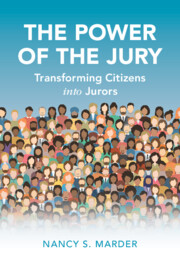Book contents
- The Power of the Jury
- Cambridge Studies in Law and Society
- The Power of the Jury
- Copyright page
- Contents
- Acknowledgments
- Introduction
- 1 The Summons and the Setting: Beginning the Transformation of Citizens into Jurors
- 2 Voir Dire: Introducing Jurors to the Judge, Their Fellow Jurors, and Their Role
- 3 Peremptory Challenges: A Barrier That Unnecessarily Limits Who Can Serve as Jurors
- 4 Jury Instructions: Reinforcing Group Identity and Making Instructions Accessible to Jurors
- 5 Jury Deliberations: Performing the Jury’s Main Task with Some Assistance from the Judge
- 6 The Post-Verdict Interview: How Judges Can Help Jurors in Their Transformation from Jurors into Engaged Citizens
- Conclusion
- Index
- Cambridge Studies in Law and Society
5 - Jury Deliberations: Performing the Jury’s Main Task with Some Assistance from the Judge
Published online by Cambridge University Press: 25 August 2022
- The Power of the Jury
- Cambridge Studies in Law and Society
- The Power of the Jury
- Copyright page
- Contents
- Acknowledgments
- Introduction
- 1 The Summons and the Setting: Beginning the Transformation of Citizens into Jurors
- 2 Voir Dire: Introducing Jurors to the Judge, Their Fellow Jurors, and Their Role
- 3 Peremptory Challenges: A Barrier That Unnecessarily Limits Who Can Serve as Jurors
- 4 Jury Instructions: Reinforcing Group Identity and Making Instructions Accessible to Jurors
- 5 Jury Deliberations: Performing the Jury’s Main Task with Some Assistance from the Judge
- 6 The Post-Verdict Interview: How Judges Can Help Jurors in Their Transformation from Jurors into Engaged Citizens
- Conclusion
- Index
- Cambridge Studies in Law and Society
Summary
Chapter 5 looks at deliberations. The traditional view of deliberations is that jurors are capable from the moment they are selected to deliberate in a way that yields a fair and just verdict. In contrast, the transformation view recognizes that jurors must perform a task for which they have not volunteered; they must be aware of their personal biases and try not to be swayed by them; they must deliberate to try to reach a unanimous verdict with a group of strangers; and they must decide the facts and apply the law even though both are new to them. However, the experiences they have gone through as jurors have helped to prepare them to deliberate. In addition, the setting and structure of the deliberations help them to maintain the necessary discipline. The jurors are secluded in the jury room; they are required to vote and to give reasons to the group; if unanimity is required they must come to a group understanding; and they must make a decision that has serious consequences. There are features of deliberations that help jurors to assume their role as jurors, such as having a foreperson, a diverse jury, a group deliberation, and the judge's instructions.
Keywords
- Type
- Chapter
- Information
- The Power of the JuryTransforming Citizens into Jurors, pp. 149 - 208Publisher: Cambridge University PressPrint publication year: 2022

